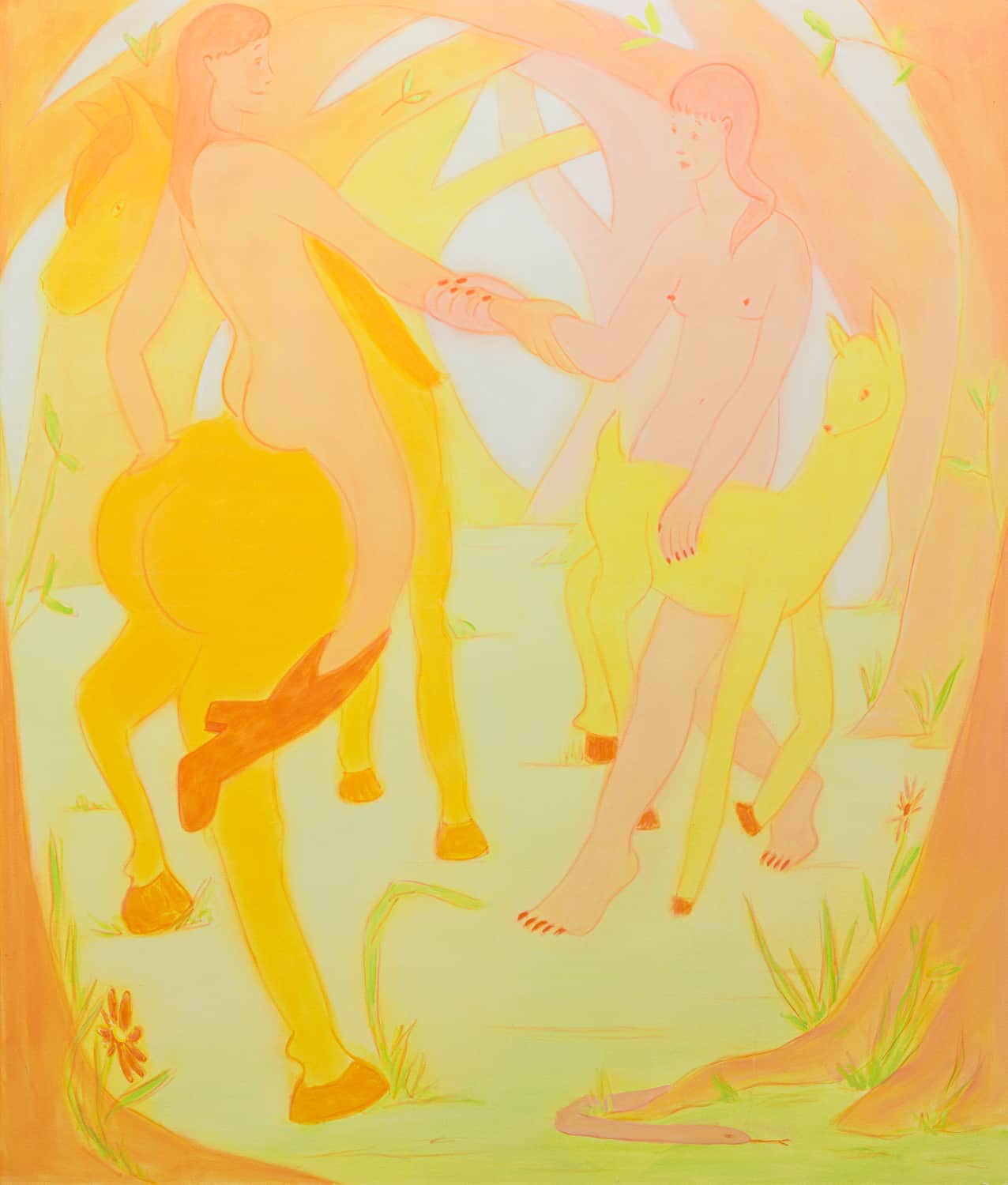
Grace Mattingly, Yellow Landscape (Deer), 2022
The most striking aspect of Grace Mattingly’s work is the use of colour. She uses a palette that is based around sugary pinks and yellows, creating visually indulgent canvases. Mattingly’s work is saturated with a joyous revelry in camp and childish colour. She creates an enveloping glow that feels warm, yet artificial – stripped of complicating wild or organic qualities. The natural world in Mattingly’s work is ethereal, whimsical and ostensibly presents a childish view. Yet, there is an exploration of erotic fantasy in these scenes that is not only found in the sexually charged imagery, but seeps through Mattingly’s particular conjunction of form and colour. Committed as her work is to these bubblegum-bright colours, Mattingly creates form by pushing the tonal possibilities of oil. A self-consciously naive style smooths her subjects into soft forms. The scenes are fantastical and acknowledge classical mythical narratives, as feminine characters play and converse with personable forest creatures. Rendered with the same shapeliness, human and animal figures share a proximity that is more than merely spatial.
Sianne Ngai’s 2012 book Our Aesthetic Categories argues it is the aesthetic categories of ‘the zany’, ‘the cute’ and ‘the interesting,’ rather than ‘the beautiful’ or ‘the sublime,’ that are vital to describing the aesthetic experience of the twenty-first century. Ngai claims that it is through these categories that we can best understand how our aesthetic experience has been transformed by the ‘hypercommodified, information-saturated, performance-driven conditions’ under which we now experience the world. The cute object for Ngai is defined by an appearance of powerlessness, of easy consumption and commodity fetishisation. The cute object provokes a ‘sentimental desire for a simpler and more sensious, more concrete relation to commodities.’ The cute is deeply associated with the infantile and the feminine and, Ngai argues, functions as a container for a naive sexuality. To code an object with cuteness involves making it appear anthropomorphically, that is, as approaching but never achieving personhood. It also involves coding the object with femininity and childishness, turning it into a commodity to be fetishised and consumed.
Yellow Landscape (Deer) makes use of many elements of Ngai’s theory, but offers more than easy cute consumption. There is a forest scene in which two women encounter two creatures. The women are nude, but not vulnerably so. One wears only high heeled boots, suggesting strength and an ownership of her nudity. Both women hold themselves with a solidness and confidence that suggests an adult strength and command of their bodies. The animals and women are formed by the same soft, curving lines. One woman stands before a creature and appears to have hooves herself; there is a partial unity of person and animal. The colours are bold and restricted to a bright, almost acidic, yellow and a softer powdery pink. This colouring appears processed and in-organic. As such, there is tension created; the colour and form failing to contain the confident sexual potency of the characters.
The connection between Mattingly’s work and Ngai’s theory is immediately clear. The use of colours that share a sweet confectionary quality evokes a consumable commodity. The naivety of simplified line, form and composition holds a sentimentality and sensuousness that plays with erotic imagery. However, there is no real sense in which Mattingly’s indulgence in cute coding creates an unequal power dynamic with the would-be consumer. Mattingly approaches and explores her themes with a confidence that denies the powerlessness of traditional cute objects. Her works play in such unashamed joy with the tension between childish fantasy and sexual exploration that there is a commanding self-posession throughout. This is an interesting aspect of Mattingly’s practice, that she can engage with an aesthetic category so ubiquitous and fundamental to understanding our aesthetic experience, and yet do so with such enjoyment that she refuses its coding. In playing with this aesthetic category, approaching, luxuriating in and ultimately rejecting the cute, Mattingly reflects an aspect of aesthetic life, but goes further, offering more than merely cute commodities
(By Tom Winter)
